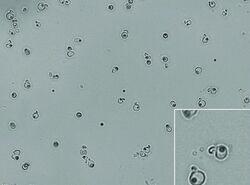Biology:Debaryomyces hansenii
| Debaryomyces hansenii | |
|---|---|

| |
| Scientific classification | |
| Kingdom: | |
| Division: | |
| Class: | |
| Order: | |
| Family: | |
| Genus: | |
| Species: | D. hansenii
|
| Binomial name | |
| Debaryomyces hansenii (Zopf) Lodder & Kreger-van Rij (1984)
| |
| Synonyms | |
| |
Debaryomyces hansenii, also known as Candida famata, is a species of yeast in the family Saccharomycetaceae.
Pathogenicity
Debaryomyces hansenii accounts for up to 2% of invasive candidiasis cases.[1] It has been found in Crohn's disease ulcerations in humans and is being investigated as the environmental trigger of Crohn's disease.[2][3] Certain strains of Debaryomyces hansenii have been researched for potential use as probiotics and may have health benefits.[4][5]
Ecology
Debaryomyces hansenii is an osmo-, halo- and xerotolerant yeast[6] that produces toxins, including mycocins, to destroy competitive yeast species.[5] It is a common species in all types of cheese, including soft cheeses and the brines of semi-hard and hard cheeses,[7] and the most common yeast among 383 isolates from samples of unsulphited or sulphited sausages, skinless sausages and minced beef.[8] It contributes to the fermentation of barrel-aged beers such as Le Coq Imperial Stout from Harveys Brewery in southern England. Harvey's head brewer speculates that it is either airborne in the brewery or a slow-growing component of their house yeast blend.[9] D. hansenii is also found in hyper-saline waters such as the salterns on the Atlantic coast of Namibia or in the Great Salt Lake of Utah.[6]
Nutritional requirements
The species can be cultivated in media with up to 25% NaCl or 18% glycerol.[6] Growth rate increases in solutions with ≥ 1M NaCl or KCl, with sodium and potassium ions playing a very important role in the mechanisms involved in maintaining osmobalance. The species can survive a pH range between 3 and 10. Furthermore, D. hansenii has been described as the species with the highest perchlorate tolerance reported to date, which might have consequences for the microbial habitability of Mars, where perchlorate salts are widely distributed.[10]
Reproduction
Most strains are haploid, mating very rarely and diploidize transiently by somatogamous autogamy (i.e. fusion of two cells but excluding their nuclei). Sexual reproduction proceeds via heterogamous conjugation (i.e. the conjugation of two cells of different form or size) leading to short diplophase followed by meiosis and ascospore formation.[6] Haploid yeasts reproduce vegetatively by multilateral budding.
Genetics
This species has seven chromosomes, labeled A-G. This species uses an alternative genetic code for the codon CUG, coding for the amino acid serine instead of the usual leucine.[11]
Differentiation
The ability of this species to grow at 10% NaCl or 5% glucose is used to discriminate D. hansenii from other ascomycetous yeasts.[6] The species comprises two varieties: D. hansenii var. hansenii and var. fabryii. These two groups can be differentiated via rRNA, the electrophoretic mobility of their glucose-6-phosphate dehydrogenase, or by their maximum grow temperatures (35 °C for var. hansenii and 39 °C for var. fabryii).
Biotechnology
The species has been demonstrated to synthesize useful quantities of D-arabinitol, riboflavin, xylitol, and pyruvic acid under thiamine limitation.[6] The species has also been used to decarboxylate ferulic acid to 2-Methoxy-4-vinylphenol via biotransformation (a 95.07% yield, 1470.8 mg/L, within 10 hours).[12]
References
- ↑ "Treatment of Candida famata bloodstream infections: case series and review of the literature". The Journal of Antimicrobial Chemotherapy 68 (2): 438–443. February 2013. doi:10.1093/jac/dks388. PMID 23085777.
- ↑ Reynolds, Sharon (March 29, 2021). "Fungi may impair wound healing in Crohn's disease". https://www.nih.gov/news-events/nih-research-matters/fungi-may-impair-wound-healing-crohns-disease.
- ↑ "Debaryomyces is enriched in Crohn's disease intestinal tissue and impairs healing in mice". Science 371 (6534): 1154–1159. March 2021. doi:10.1126/science.abd0919. PMID 33707263. Bibcode: 2021Sci...371.1154J.
- ↑ "In vitro investigation of Debaryomyces hansenii strains for potential probiotic properties". World Journal of Microbiology & Biotechnology 32 (9): 141. September 2016. doi:10.1007/s11274-016-2109-1. PMID 27430508.
- ↑ 5.0 5.1 "Killer toxin from several food-derived Debaryomyces hansenii strains effective against pathogenic Candida yeasts". International Journal of Food Microbiology 222 (2): 23–9. April 2016. doi:10.1016/j.ijfoodmicro.2016.01.016. PMID 26828815. http://digitalcommons.unl.edu/cgi/viewcontent.cgi?article=1008&context=bioscinickerson.
- ↑ 6.0 6.1 6.2 6.3 6.4 6.5 "Debaryomyces hansenii--an extremophilic yeast with biotechnological potential". Yeast 23 (6): 415–437. April 2006. doi:10.1002/yea.1374. PMID 16652409.
- ↑ "Yeasts in dairy products". The Journal of Applied Bacteriology 68 (3): 199–211. March 1990. doi:10.1111/j.1365-2672.1990.tb02566.x. PMID 2187843.
- ↑ "The yeasts of British fresh sausage and minced beef". Antonie van Leeuwenhoek 50 (3): 227–248. 1984. doi:10.1007/BF02342134. PMID 6486769.
- ↑ Washington hosts historic tasting of British and Irish classics, 6 April 2001, http://www.beerhunter.com/documents/19133-001504.html
- ↑ "A New Record for Microbial Perchlorate Tolerance: Fungal Growth in NaClO4 Brines and its Implications for Putative Life on Mars". Life 10 (5): 53. April 2020. doi:10.3390/life10050053. PMID 32353964.
- ↑ "Debaryomyces hansenii (ID 195) - Genome - NCBI". https://www.ncbi.nlm.nih.gov/genome/?term=Debaryomyces_hansenii%5Borgn%5D.
- ↑ "Rapid conversion of ferulic acid to 4-vinyl guaiacol and vanillin metabolites by Debaryomyces hansenii". Journal of Molecular Catalysis B: Enzymatic 44 (2): 48–52. 2007. doi:10.1016/j.molcatb.2006.09.001.
External links
Wikidata ☰ Q10467497 entry
 |

